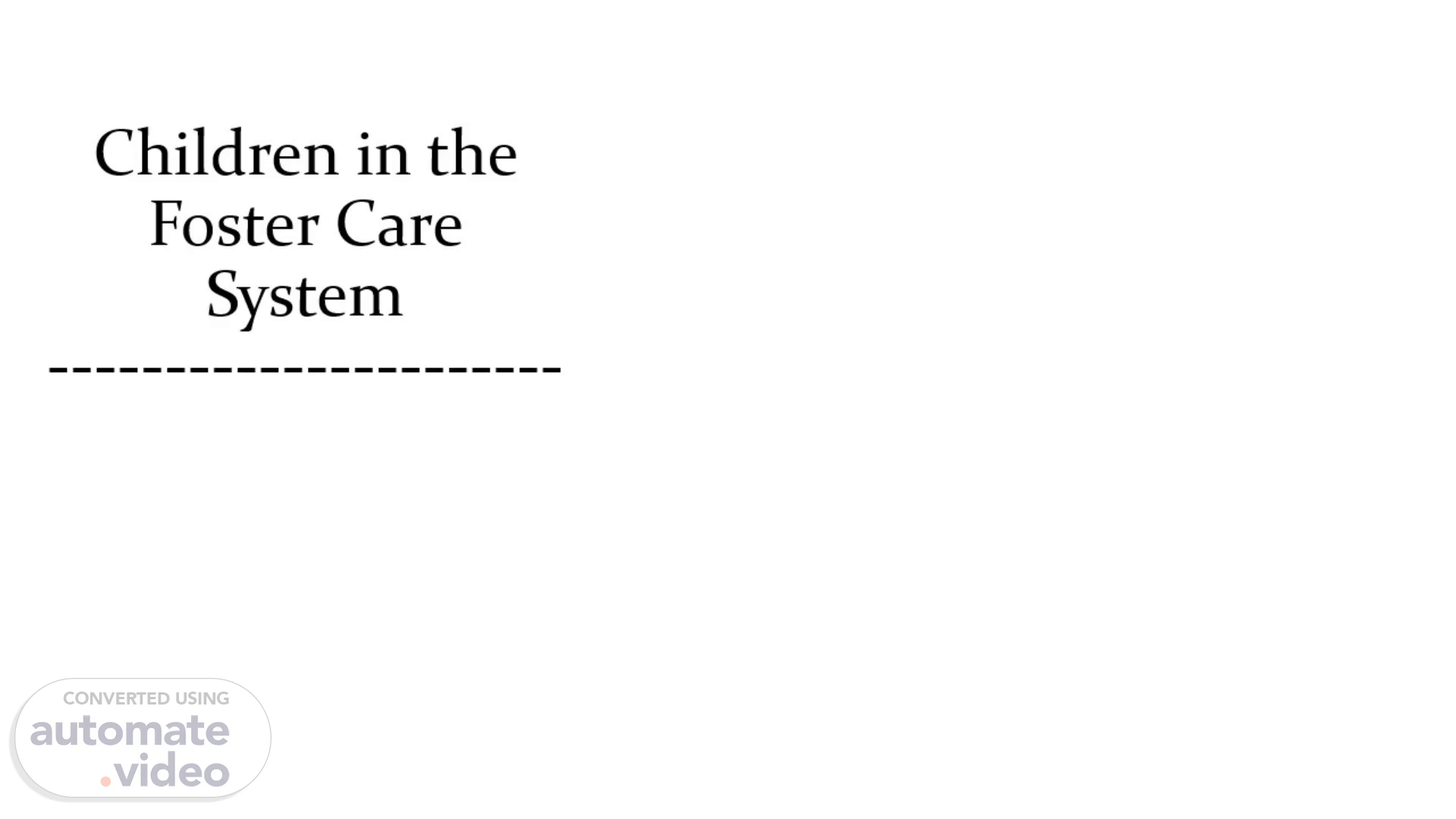
Children in the Foster Care System ----------------------
Scene 1 (0s)
Children in the Foster Care System -. Sarai De Leon California State University, Dominguez Hills CDV 380: Stress, Risk, & Resilience Dr. Izabela Grey April 15, 2024.
Scene 2 (21s)
What is the Foster Care System?. [image] Raising Awareness for National Foster.
Scene 3 (37s)
Demographics. Children who are often at risk of being part of the welfare system are those who go through traumatizing events in regards to their Socioeconomic Status (SES), environment, and other factors. Can experience but are not limited to: Abuse Neglect Parental substance abuse.
Scene 4 (1m 2s)
Ecological Systems Theory. Bronfenbrenner's Ecological Systems Theory holds the idea that a person's surrounding environments can easily influence their behaviors as they grow. Through the 5 components of this theory, there are factors that can either hinder or benefit one's development; these are called risk and protective factors..
Scene 5 (1m 23s)
Risk & Protective Factors. Microsystem Risk: Unstable household when child is being neglected/abused Protection: Healthy family relationship.
Scene 6 (1m 38s)
Risk & Protective Factors. Mesosystem Risk: Disconnection between parent of child and child's environment with foster parents Protection: Relationship between foster parent and child's CASA.
Scene 7 (1m 59s)
Public Domain Pictures. Risk & Protective Factors.
Scene 8 (2m 12s)
Overview of Research- Physical. A study conducted by Lee et al. (2014) examines the physical effects of being placed in the welfare system. Foster care children are more likely to have poorer health compared to their non-foster care peers. This could lead to these adolescents engaging in more risky behaviors like drinking and indulging in drugs which can also have a physical toll on them. (Lee et al., 2014).
Scene 9 (2m 35s)
Overview of Research- Cognitive. Children who face the realities of the foster care system oftentimes face many developmental challenges. Poor behavior skills are also likely to be affected. Can cause difficulties: Grasping onto concepts Building and keeping relationships Attention span Attachment styles/Responses (Tooley et al., 2016; Gunnar, 2022).
Scene 10 (2m 53s)
Overview of Research- Psychological/Social Emotional.
Scene 11 (3m 12s)
CASA Intervention. [image] CASA of Los Angeles CASAofLA X.
Scene 12 (3m 33s)
FHF Intervention. Fostering Healthy Futures (FHF) is and intervention that bases its goals on mentoring youth who have experienced the foster care system. Mentors assist these children with skill training, personal growth, and encouragement that will benefit them in the future. Research found that those were part of FHF produced more positive outcomes with themselves and others even after facing adversity. (Weiler et al., 2022).
Scene 13 (3m 56s)
Conclusions. Author's Conclusions: Authors concluded that goals that were set for both interventions were met. FHF and CASA continue to be reliable sources of support and empower foster youth throughout the process. Outcomes proved these interventions to be beneficial to all. Personal Conclusions: After learning about these interventions I believe foster youth should have access to these programs to not only have a support system but also minimize the levels of risk to those in jeopardy of being placed in foster care..
Scene 14 (4m 20s)
Discussion Activity. Game Pin: 08365988 Link: https://kahoot.it/challenge/08365988?challenge-id=2d14c4aa-9b50-4a90-bbf4-ab5f9413de99_1713067472410.
Scene 15 (4m 31s)
References Gunnar, M. R. (2022). The importance of a family for cognitive development: A commentary. Proceedings of the National Academy of Sciences of the United States of America, 119(39), 1–2. https://doi-org.libproxy.csudh.edu/10.1073/pnas.2213908119 Harden, B.J., Morrison, C., & Clyman, R.B. (2014). Emotion labeling among young children in foster care. Early education and Development, 25(1), 1180-1197. https://doi.org/10.1080/10409289.2014.907694 Katz, C. C., & Geiger, J. M. (2021). The role of court appointed special advocates (casas) in the lives of transition-age youth with foster care experience. Child & Adolescent Social Work Journal, 40(1), 17-27. https://doi-org.libproxy.csudh.edu/10.1007/s10560-021-00759-8 Kortenkamp, K. & Erhle, J. (2002). The well-being of children involved in the child welfare system: A national overview. The Urban Institute, 43(1) 1-8. Lappan, S. N., Parra-Cardona, J. R., Carolan, M., & Weatherspoon, L. (2020). Risk and protective factors associated with childhood obesity in a sample of low-income, single female, parent/guardian households: Implications for family therapists. Family Process, 59(2), 597–617. https://doi.org/10.1111/famp.12440 Lee, K. (2023). Effects of formal center-based care and positive parenting practices on children in foster care. Child Abuse & Neglect, 142(1), 1–12. https://doi-org.libproxy.csudh.edu/10.1016/j.chiabu.2022.105946 Nelson, C.A., Fox, N.A., & Zeanah, C.H. (2023). Romania’s abandonded children: the effects of early profound psychosocial deprivation on the course of human development. Sage Publications, 32(6), 515-521. https://doi.org/10.1177/09637214231201079 Piel, M. H., Geiger, J. M., Julien, C. F. J., & Lietz, C. A. (2017). An ecological systems approach to understanding social support in foster family resilience. Child & Family Social Work, 22(2), 1034–1043. https://doi-org.libproxy.csudh.edu/10.1111/cfs.12323 Rijbroek, B., Strating, M. M. H., Konijn, H. W., & Huijsman, R. (2019). Child protection cases, one size fits all? Cluster analyses of risk and protective factors. Child Abuse & Neglect, 95(1), 1-14. https://doi-org.libproxy.csudh.edu/10.1016/j.chiabu.2019.104068 Tooley, U. A., Makhoul, Z., & Fisher, P. A. (2016). Nutritional status of foster care children in the US: Implications for cognitive and behavioral development. Children and Youth Services Review, 70(1), 369-374. http://dx.doi.org.libproxy.csudh.edu/10.1016/j.childyouth.2016.10.027 USAFacts. (2023). How many kids are in foster care in the US? https://usafacts.org/articles/how-many-kids-are-in-foster-care/#:~:text=By%202021%2C%20white%20children%20made,Pacific%20Islander%2C%20or%20unknown%20descent. Weiler, L. M., Lee, S., Zhang, J., Ausherbauer, K., Schwartz, S. E. O., Kanchewa, S. S., & Taussig, H. N. (2022). Mentoring children in foster care: Examining relationship histories as moderators of intervention impact on children’s mental health and trauma symptoms. American Journal of Community Psychology, 69(2), 100–113. https://doi-org.libproxy.csudh.edu/10.1002/ajcp.12549.